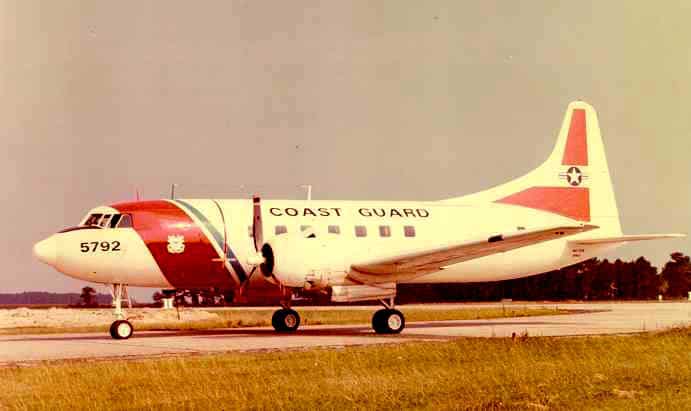
A full scale wing fatigue test was conducted to determine whether – or when — major repair or replacement of the HU-16Es wing would be required. The test was completed on October 31, 1968 and a wing service life of 11,000 flight hours was established. The Coast Guard explored the possibility of utilizing a mixed fleet of HH-3F helicopters and C-130s. It did not prove a viable option. In 1971 the Coast Guard Aircraft Characteristics Board convened to develop operating characteristics and performance requirements for the HU-16E replacement and established a requirement for forty-one MRS aircraft. The ever faithful “goat” had served long and well. Several multi-engine aircraft were leased for evaluation. As a result of the evaluations it was decided to obtain the North American Rockwell Sabre Model 40. The Sabre had the cabin interior volume required; had an established history and as the T-39 was being procured by the military. The Decision was made to proceed with the issuance of a Military Interservice Procurement Request (MIRP) with the Navy acting as purchasing agent.
The decision to proceed with a non-competitive procurement drew some sharp industry and congressional criticism. The Commandant directed the cancellation of the MIRP and initiated a competitive two-step, formally advertised, procurement. The request for proposals went out in January of 1975. The HU-16Es were being taken out of service due to flight time limitations and it became apparent that an interim MRS aircraft had to be obtained. The Falcon HU-25A would become the MRS aircraft; the first coming on line in July of 1979. The rest followed at the rate of one per month.
Beginning in late 1975, under the direction of Commander Art Wagner, a search for an interim MRS replacement began. A business jet lease option was evaluated but none had the proper assets and the cost was high. Airline Turbo Props being replaced by jets were evaluated but the T-56 and Rolls powered Convairs were very high time as were the Viscounts and Fairchild’s. An interim report was drawn up to that effect. The Commandant, Admiral Owen Siler, then contacted the Air Force and Navy and the Coast Guard was granted full access to anything stored at the Davis Monthan Storage Facility that met Coast Guard requirements.
There were a number of P2 aircraft but with R3350 engines, a Varicam stabilizer, two J85s on the wing, they would have been costly to operate and maintenance intensive. There were a number of S2s with R1820 engines which would have been a good fit but they had come off Carriers and then sent to the training command. They were not in good shape and were limited on interior cabin space. There were a number of C-131s but they were of every version imaginable and it seemed there were no two alike in configuration. A check of the records, however, revealed that there were almost thirty former MedEvac C-131As, a version of the Convair 240/340 series commercial airliner, all with radar, all with APUs, and all identical in cockpit configuration. They averaged 20,000 flight hours on a 60,000 hour airframe and it was all airways flying. The Air Force was supplying support for the few remaining operational C-131 aircraft as was the Arizona Air Guard. In addition, it was discovered that there were approved plans for a camera hatch (became the drop hatch) and big windows in the side of the fuselage. It was a good fit.
In 1976, the Coast Guard acquired seventeen C-131A transports from US Air Force stock as the interim replacement for the HU-16E Albatross. They were to be used for search and rescue flights as well as surveillance patrols of the new 200 mile exclusive fisheries zone. The Coast Guard refurbished and modified one aircraft per month from September 1976 through January 1978. Fourteen aircraft were acquired from Davis-Monthan Air Force Base and three others were transferred from Air National Guard stocks. For spare parts, three other C-131As were held in reserve at Davis-Monthan and another was acquired for use at the training school located at ARSC Elizabeth City.
After initial flight trials the Coast Guard modified the aircraft by adding specialized electronics and search and rescue equipment. Each aircraft first underwent an overhaul at Hayes International in Dothan, Alabama. They were then flown to ARSC Elizabeth City for Coast Guard-specific modification. The following electronic systems were added or if already installed, upgraded: AN/ARA-25 UHF/VHF (AM-FM) DF; AN/ARC-84 VHF transceiver; AN/ARC-94 HF transceiver; AN/ARC-160 VHF-FM transceiver; AN-ARN-44 LF ADF receiver; AN/APM-171 radio altimeter; AN/APN-195 radar; ADL-81 LORAN C receiver; and the necessary antennae. The following structural modifications were also made: installation of a drop hatch; the addition of a radio operator/navigator position and two positions for search-observers; an acoustic locator beacon known as “Pinger”; a mount for the airborne radiation thermometry (ART) sensor; and the reconfiguration of the cargo area.
As the modifications were completed, the aircraft then flew to the AVTRACEN in Mobile, Alabama, for crew and ground personnel familiarization training. The aircraft were assigned to Coast Guard air stations Miami, Corpus Christi, San Francisco, Traverse City and AVTRACEN Mobile. The aircraft were retired as the new HU-25A entered Coast Guard service.
| Manufacturer | Convair Aircraft Corporation, San Diego, California |
| Designation | HC-131A |
| Wing Span | 105′ 4″ |
| Height | 28′ 2″ |
| Length | 79′ 2″ |
| Fuel Capacity | 920 gallons |
| Cruising Speed | 250 mph |
| Range | 450 statute miles |
| Empty Weight | 29,248 lbs. |
| Gross Weight | 47,000 lbs. |
| Crew | 3 |
| Passengers/freight | 27,000 lbs. |
| Service Ceiling | 24,500′ |
| Engine(s) | 2 x 2,500 hp Pratt & Whitney R-2800-99W |

